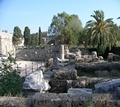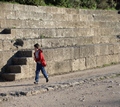
The acropolis of Rhodes dominated the western and highest part of the city. It did not have a fortified character like the old citadels. It was a monumental zone with Sanctuaries, large temples, public buildings and underground places of worship. The buildings were built in steps at different levels, on shaped platforms, which were held by strong retaining walls. It was "full of fields and groves" according to the description of the orator Ailios Aristides (2nd century AD). The spirit of Hellenistic architecture in the acropolis of Rhodes is perfectly expressed by the combination of natural beauty with artificial interventions. The monuments of the acropolis date back to the Hellenistic and Late Hellenistic eras. (3rd-2nd century BC)
The most important monuments uncovered by the archaeological dig are:
Temple of Athena Poliados and Zeus Polieos: Located at the northernmost end of the Acropolis hill. It was oriented from A. to W. It was of the Doric style, porino pavilion (that is, it had a portico with columns on the four outer sides). The nine oversized vertebrae, part of the capital and architrave, now in the ground, indicate its monumental character. Here the Rhodians kept the texts of the treaties with the other states. The temple was part of a wider mosque that was defined by a portico to the east.
"Nymphea":They are located east and south of the portico wall. These are four underground cavernous structures carved into the rock with entrance stairs, corridors, communication and a large opening in the central part of their roof. On their inner sides there are niches for placing statuettes. Tanks and lush vegetation completed the landscape. They were places of recreation and worship.
Temple of Pythia Apollo: It is located in the southern part of the hill, on the western side of a large rectangular plateau. It was oriented A-D. It was a portico, a pavilion, but of smaller dimensions than the temple of Athena and Zeus. Part of its BA side with four columns and part of the portico has been restored.
Stoic building:Today the wall of the foundation of the portico is preserved which must have created an impressive facade visible from the lower city and the ports.
Artemisium: On the BA side of the same plateau are the remains of other places of worship, one of which is attributed to the worship of Artemis.
Stadium: At the NE foot of the hill is the BN oriented Stadium, excavated and restored by the Italians. It was one Stadia long, i.e. 600 feet or 201 meters. Authentic parts of it are preserved in the sling, in the positions of the officials (chairs) and in some of the lower seats (edolia). Also preserved is the location where the mechanism for starting the athletes was (surprise).
High school:The Gymnasium was located to the east of the Stadium. Part of its western side had previously been exposed and recently its BA end was identified under the canteen. It was a large square building with a side of about 200 m. It was famous for the artistic works it contained.
Library: A very important Library with valuable writings mainly of a rhetorical nature was located near the Gymnasium and the Conservatory, as an inscription found in the area allows us to conclude.
Conservatory: North-west of the Stadium is a restored small marble Conservatory. It had a capacity of about 800 spectators and it is believed that it would have been used either to hold musical events or as a place to attend classes of the famous orators of Rhodes.
Source: Ministry of Culture and Sports
odysseus.culture.gr







